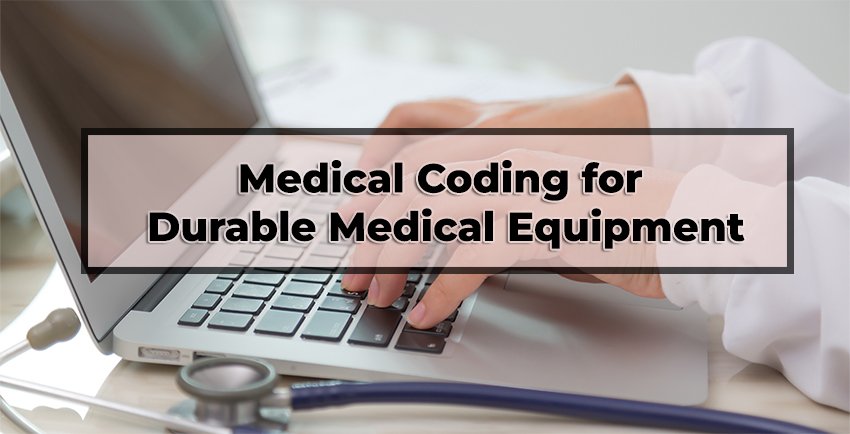Medical Coding for Durable Medical Equipment (DME)
Durable Medical Equipment (DME) refers to medical devices and supplies that are designed for long-term use, primarily for patients with chronic conditions or those recovering from surgeries or injuries. These devices help improve a patient’s quality of life by supporting their mobility, respiratory function, or daily living needs. Examples of DME include wheelchairs, walkers, hospital beds, oxygen tanks, and nebulizers.

Accurate coding of DME is critical for healthcare providers to ensure proper reimbursement, meet compliance standards, and document the specific needs of patients. DME coding involves the use of HCPCS Level II (Healthcare Common Procedure Coding System) codes, which represent the specific equipment, supplies, and devices provided. Coders must be familiar with these codes and their correct application, as they play an essential role in billing and ensuring the patient’s medical necessity for each piece of equipment.
Key Components of DME Coding
DME coding requires an understanding of both the equipment being provided and the patient’s medical condition that justifies its use. Coders need to ensure that each piece of equipment is linked to an appropriate diagnosis that supports its medical necessity.
1. Common Types of DME and Their Codes:
Wheelchairs: There are several types of wheelchairs, ranging from standard manual chairs to more complex power-operated models. For instance, HCPCS code E1130 represents a standard wheelchair, while E1161 is used for a manual, adjustable, hemi-height wheelchair.
Hospital Beds: Hospital beds come in various forms, such as semi-electric or fully electric beds. HCPCS code E0260 represents a semi-electric hospital bed, while E0303 covers a fully electric hospital bed.
Oxygen and Respiratory Devices: For patients with respiratory issues, oxygen concentrators and nebulizers are frequently prescribed. HCPCS code E1390 covers an oxygen concentrator, while E0570 is used for a nebulizer.
2. Medical Necessity and Documentation:
Proper coding for DME requires a clear link between the patient’s medical condition and the equipment prescribed. For example, a patient diagnosed with COPD might require an oxygen concentrator, which must be justified by documenting the severity of the condition and the need for long-term oxygen therapy.
Coders must ensure that documentation includes physician orders, patient diagnosis, and any other relevant information that demonstrates the medical necessity of the equipment. This is especially important for payers like Medicare, which have strict requirements for DME coverage.
3. Rentals vs. Purchases:
Some DME items are typically rented rather than purchased, depending on the patient’s condition and the anticipated duration of use. Coders must be aware of the correct codes for rental versus purchase of DME. For example, E0260-RR denotes a semi-electric hospital bed rented monthly, while E0260 without the -RR modifier indicates a purchase.
Special Considerations in DME Coding
DME coding comes with its own set of unique challenges, particularly around payer guidelines and coverage limitations. Medicare, Medicaid, and private insurers often have specific rules governing the types of DME covered, the conditions under which they are approved, and how frequently they can be replaced or upgraded. Coders must stay informed about these rules to avoid denied claims.
Medicare Guidelines for DME:
Medicare typically covers DME under Part B, but only if the equipment is deemed medically necessary by a physician and meets certain criteria. For example, the equipment must be durable, reusable, and necessary for use within the home. Coders must ensure that Medicare's requirements are met when submitting claims for DME reimbursement.
Use of Modifiers in DME Coding:
DME coding often requires the use of modifiers to communicate specific details about the service provided. For example, modifier -RR is used to indicate rental equipment, while modifier -NU denotes a new purchase. Modifier -UE is applied when used equipment is provided. Coders must apply these modifiers correctly to ensure accurate billing and compliance with payer requirements.
Challenges in DME Coding
One of the key challenges in DME coding is navigating the various payer-specific requirements. Payers often impose strict documentation requirements to verify the medical necessity of the equipment. Coders must ensure that all required documentation is submitted, including the physician’s order, detailed written order (DWO), and supporting clinical notes.
Another challenge is ensuring that equipment replacement or upgrades are properly coded. Payers often limit how frequently certain DME items can be replaced. For instance, a new wheelchair may only be covered every five years, unless there is a significant change in the patient’s condition. Coders need to be aware of these limitations and ensure that replacement claims are justified and supported with proper documentation.
Best Practices for Accurate DME Coding
Thorough Documentation: Coders should ensure that all necessary documentation is provided to support the medical necessity of the DME. This includes the physician’s prescription, patient diagnosis, and any relevant clinical notes that justify the use of the equipment.
Understanding Payer-Specific Rules: Coders must be familiar with the specific coverage guidelines for each payer, especially when it comes to Medicare and Medicaid. Knowing the replacement schedules, documentation requirements, and limitations for each type of equipment helps to ensure that claims are processed smoothly and without delay.
Accurate Use of Modifiers: Proper use of modifiers is essential in DME coding to indicate the status of the equipment, whether it’s rented or purchased, and whether it’s new or used. Coders should carefully apply modifiers to prevent billing errors.
Medical coding for Durable Medical Equipment (DME) is a complex and essential aspect of healthcare, ensuring that patients receive the equipment they need to improve their quality of life. Accurate DME coding not only ensures proper reimbursement but also helps healthcare providers maintain compliance with regulatory standards. By understanding the different types of DME, coding guidelines, and payer requirements, coders play a crucial role in supporting patient care.
With the correct application of HCPCS codes, modifiers, and documentation practices, coders can ensure that DME claims are processed accurately and that patients receive the support they need to manage their health conditions effectively. Staying informed about payer policies, DME updates, and coding best practices will continue to be essential for accurate and compliant DME coding.

